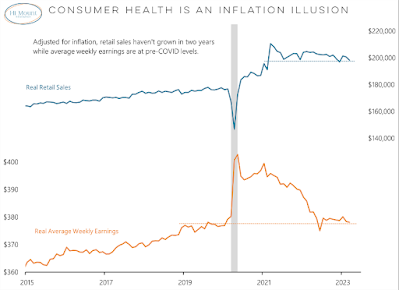*** denotes well-worth reading in full at source (even if excerpted extensively here)
Economic and Market Fare:
..... I and others have spent much ink in showing that both these theories do not explain inflation in prices, either now or in the past. And it’s not just leftists. For example, economists at the Bank for International Settlements (BIS), hardly a leftist body, found that: “by some measures, the current environment does not look conducive to such a spiral. After all, the correlation between wage growth and inflation has declined over recent decades and is currently near historical lows.”
Banking Fare:
... The possibility of a repetition of 1929 or 2008 indeed looks slim, and the stakes for First Republic are not as high as they were in many of the tense meetings in the fall of 15 years ago. But the possibility that the difficulties for the banks continue to put a lead weight on the economy is very real. With rates and the yield curve where they are at present, there’s a real chance of a serious economic slowdown. And that in turn is why so many are prepared to bet that the Fed won’t keep rates where they are for much longer, and that encourages them to keep paying for stocks.
Quotes of the Week:
Charts:
1:
If we look at the "big four" coincident indicators at each recession start going back to the 1960s, what do we find?
— Eric Basmajian (@EPBResearch) April 29, 2023
We see that coincident indicators always look great at the start of recessions!
There's not a lot of red in that table.
3/5 pic.twitter.com/ffjt9yWrZG
The largest component of GDP is Consumption, but Investment is the better predictor of recession. https://t.co/viYBRjwfQv
— MacroMicro (@MacroMicroMe) April 30, 2023
...
...1/4
— Patrick Zweifel (@PkZweifel) April 26, 2023
What is different about this cycle?
Starting point is the peak of the residential cycle, as it has caused 7 of the 10 past recessions, which are used to compare to the current cycle
The collapse of housing today (-21%) is very similar to that of the previous 7 cycles (-20%) pic.twitter.com/6ZXBUbwVAg
...Given that a deeper look at GDP reveals a significantly stronger picture than the headline number suggests, what's the problem?
— Steven Anastasiou (@steveanastasiou) April 29, 2023
Look at the chart below - notice anything unusual?
The big jump in PCEs for Q1 was driven by seasonal adjustments in January. pic.twitter.com/3nqFI5E4k7
...The data is subject to huge revisions, so looking for even non-linearity using "fake" data may not be effective. pic.twitter.com/F5UvxfeWQC
— Kayfabe (@kayfabecapital) April 30, 2023
“We stay bearish as economic ambiguity of 2023 set to end with crack in labor market and EPS recession,” BofA's Hartnett wrote in an April 27 note, per Bloomberg. pic.twitter.com/ReZHWL2YZ1
— Markets & Mayhem (@Mayhem4Markets) April 28, 2023
Tweet Vid:
DRUCKENMILLER
— Win Smart, CFA (@WinfieldSmart) April 29, 2023
HARD LANDING pic.twitter.com/67wOcpMUw5
Sci Fare:
Other Fare:
Pics of the Week:













No comments:
Post a Comment